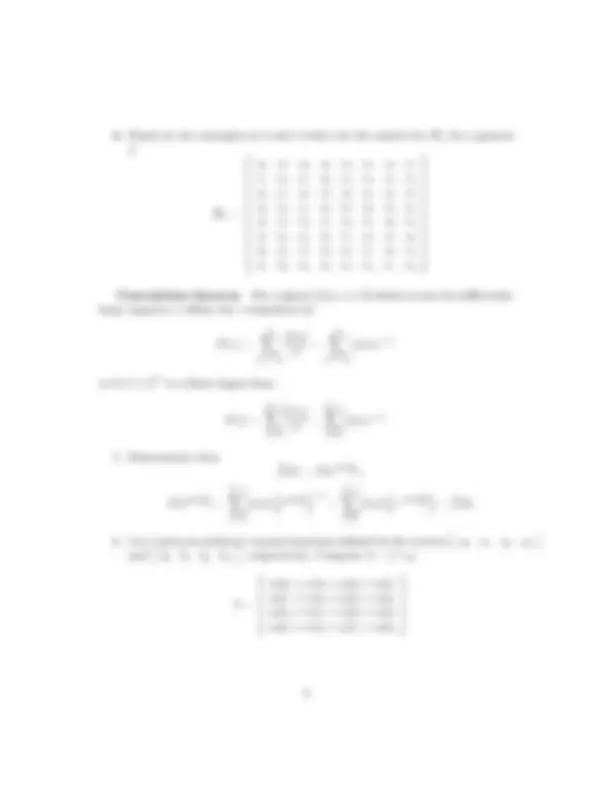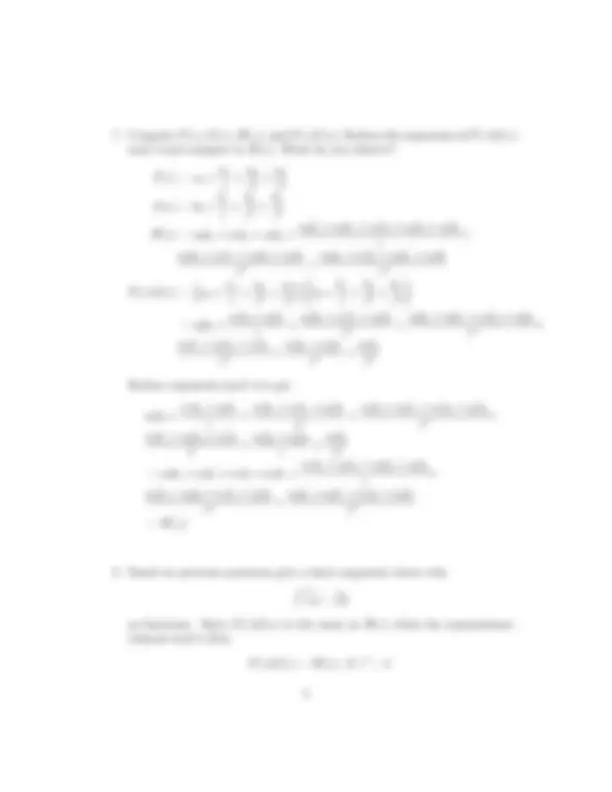





Study with the several resources on Docsity

Earn points by helping other students or get them with a premium plan


Prepare for your exams
Study with the several resources on Docsity

Earn points to download
Earn points by helping other students or get them with a premium plan
Community
Ask the community for help and clear up your study doubts
Discover the best universities in your country according to Docsity users
Free resources
Download our free guides on studying techniques, anxiety management strategies, and thesis advice from Docsity tutors
The concept of circular convolution in the context of mathematics of image processing. It provides formulas for calculating the convolution of two signals, f and g, with n samples each. The document also includes examples with different values of n and signals defined by vectors. It further discusses the convolution theorem and demonstrates its validity.
Typology: Assignments
1 / 5

This page cannot be seen from the preview
Don't miss anything!




Name: Box #:
Circular convolution Let f and g be two signals with N samples each.
The circular convolution of f and g is the n point sample given by:
f ∗ g(k) =
r=
f (k − r)g(r) =
r=
f (r)g(k − r) (mod N )
The mod N means that we use clock arithmetic in computing k − r, or that we
assume that f and g are defined for all integers , but are periodic with period N ,
i.e., f (k + N ) = f (k), g(k + N ) = g(k). For example, suppose that N = 4 and
that f and g are defined by vectors [x 0 , x 1 , x 2 , x 3 ] and [y 0 , y 1 , y 2 , y 3 ] :
f (r) = xr mod 4, g(r) = yr mod 4.
Then
f ∗ g(0) =
3 ∑
r=
f (−r)g(r) = f (0)g(0) + f (−1)g(1) + f (−2)g(2) + f (−3)g(3)
= f (0)g(0) + f (3)g(1) + f (2)g(2) + f (1)g(3)
= x 0 y 0 + x 3 y 1 + x 2 y 2 + x 1 y 3
f ∗ g(1) = x 1 y 0 + x 0 y 1 + x 3 y 2 + x 2 y 3
f ∗ g(2) = x 2 y 0 + x 1 y 1 + x 0 y 2 + x 3 y 3
f ∗ g(3) = x 3 y 0 + x 2 y 1 + x 1 y 2 + x 0 y 3
1 2
, f (1) =
1 2
f (r) = 0 otherwise. Let g be defined by
an arbitrary vector [y 0 , y 1 ,... , y 7 ]. Find the formulas (for eight samples) for
f ∗ g. y 0 +y 7 2 y 1 +y 0 2 y 2 +y 1 2 y 3 +y 2 2 y 4 +y 3 2 y 5 +y 4 2 y 6 +y 5 2 y 7 +y 6 2
f ∗ g(0)
f ∗ g(1)
. . .
f ∗ g(7)
= Hf Y = Hf
y 0
y 1
. . .
y 7
Hf =
write out the matrix for Hf.
Hf =
x 0 0 0 0 0 0 0 x 1
x 1 x 0 0 0 0 0 0 0
0 x 1 x 0 0 0 0 0 0
0 0 x 1 x 0 0 0 0 0
0 0 0 x 1 x 0 0 0 0
0 0 0 0 x 1 x 0 0 0
0 0 0 0 0 x 1 x 0 0
0 0 0 0 0 0 x 1 x 0
mod 4 and compare to H(z). What do you observe?
F (z) = a 0 +
a 1
z
a 2
z^2
a 3
z^3
G(z) = b 0 +
b 1
z
b 2
z
2
b 3
z
3
H(z) = a 0 b 0 + a 1 b 3 + a 2 b 2 +
a 3 b 1 + a 0 b 1 + a 1 b 0 + a 2 b 3 + a 3 b 2
z
a 0 b 2 + a 1 b 1 + a 2 b 0 + a 3 b 3
z
2
a 0 b 3 + a 1 b 2 + a 2 b 1 + a 3 b 0
z
3
F (z)G(z) =
a 0 +
a 1
z
a 2
z^2
a 3
z^3
b 0 +
b 1
z
b 2
z^2
b 3
z^3
= a 0 b 0 +
a 1 b 0 + a 0 b 1
z
a 2 b 0 + a 1 b 1 + a 0 b 2
z^2
a 3 b 0 + a 2 b 1 + a 1 b 2 + a 0 b 3
z^3
a 3 b 1 + a 2 b 2 + a 1 b 3
z
4
a 3 b 2 + a 2 b 3
z
5
a 3 b 3
z
6
Reduce exponents mod 4 to get
a 0 b 0 +
a 1 b 0 + a 0 b 1
z
a 2 b 0 + a 1 b 1 + a 0 b 2
z
2
a 3 b 0 + a 2 b 1 + a 1 b 2 + a 0 b 3
z
3
a 3 b 1 + a 2 b 2 + a 1 b 3
a 3 b 2 + a 2 b 3
z
a 3 b 3
z^2
= a 0 b 0 + a 2 b 2 + a 1 b 3 + a 3 b 1 +
a 1 b 0 + a 0 b 1 + a 3 b 2 + a 2 b 3
z
a 3 b 3 + a 2 b 0 + a 1 b 1 + a 0 b 2
z^2
a 3 b 0 + a 2 b 1 + a 1 b 2 + a 0 b 3
z^3
= H(z)
f̂ ∗ g = f̂ ̂g
as functions. Since F (z)G(z) is the same as H(z) when the exponentsare
reduced mod 4 then
F (z)G(z) = H(z), if z
4 = 1.
But then
f̂ ∗ g(k) = H(e^2 πi^
k (^4) )
= F (e
2 πi k 4 )G(e
2 πi k 4 )
= f̂ (k)̂g(k).